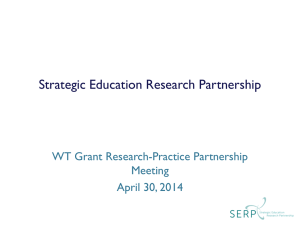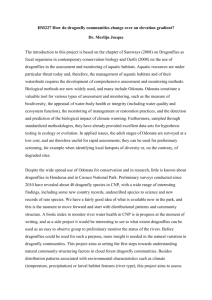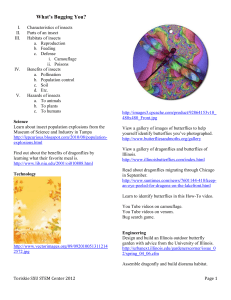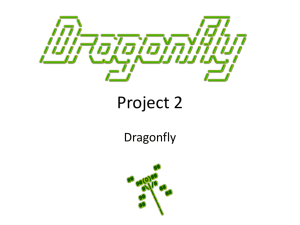Migratory Dragonfly Partnership
advertisement
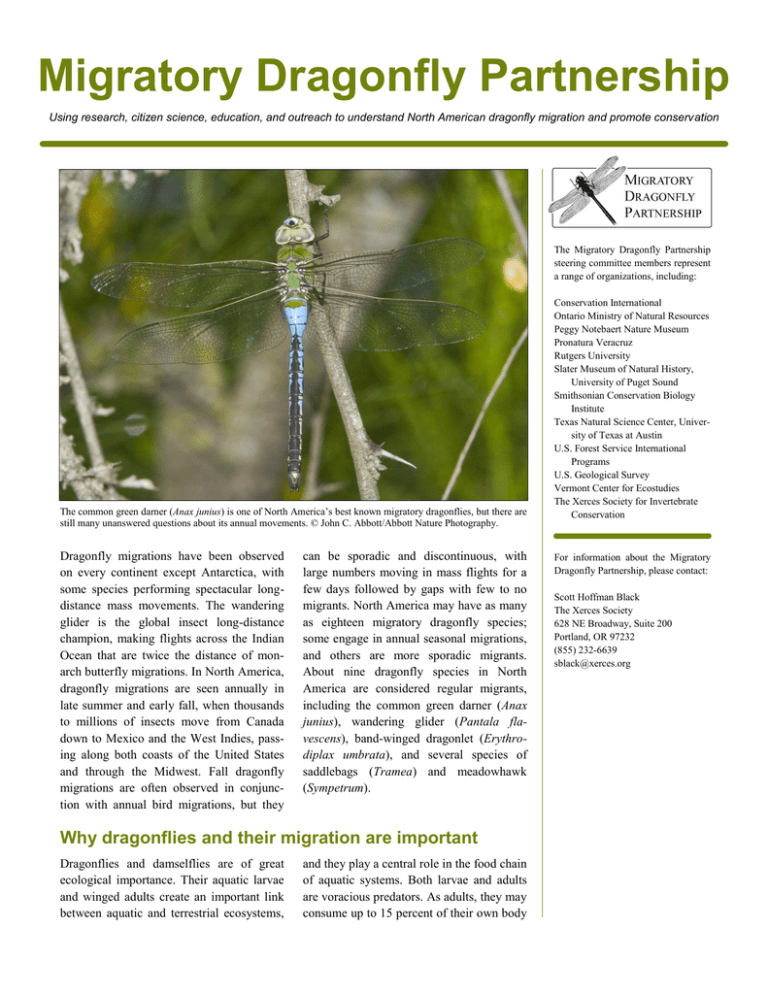
Migratory Dragonfly Partnership Using research, citizen science, education, and outreach to understand North American dragonfly migration and promote conservation The Migratory Dragonfly Partnership steering committee members represent a range of organizations, including: The common green darner (Anax junius) is one of North America’s best known migratory dragonflies, but there are still many unanswered questions about its annual movements. © John C. Abbott/Abbott Nature Photography. Dragonfly migrations have been observed on every continent except Antarctica, with some species performing spectacular longdistance mass movements. The wandering glider is the global insect long-distance champion, making flights across the Indian Ocean that are twice the distance of monarch butterfly migrations. In North America, dragonfly migrations are seen annually in late summer and early fall, when thousands to millions of insects move from Canada down to Mexico and the West Indies, passing along both coasts of the United States and through the Midwest. Fall dragonfly migrations are often observed in conjunction with annual bird migrations, but they can be sporadic and discontinuous, with large numbers moving in mass flights for a few days followed by gaps with few to no migrants. North America may have as many as eighteen migratory dragonfly species; some engage in annual seasonal migrations, and others are more sporadic migrants. About nine dragonfly species in North America are considered regular migrants, including the common green darner (Anax junius), wandering glider (Pantala flavescens), band-winged dragonlet (Erythrodiplax umbrata), and several species of saddlebags (Tramea) and meadowhawk (Sympetrum). Why dragonflies and their migration are important Dragonflies and damselflies are of great ecological importance. Their aquatic larvae and winged adults create an important link between aquatic and terrestrial ecosystems, and they play a central role in the food chain of aquatic systems. Both larvae and adults are voracious predators. As adults, they may consume up to 15 percent of their own body Conservation International Ontario Ministry of Natural Resources Peggy Notebaert Nature Museum Pronatura Veracruz Rutgers University Slater Museum of Natural History, University of Puget Sound Smithsonian Conservation Biology Institute Texas Natural Science Center, University of Texas at Austin U.S. Forest Service International Programs U.S. Geological Survey Vermont Center for Ecostudies The Xerces Society for Invertebrate Conservation For information about the Migratory Dragonfly Partnership, please contact: Scott Hoffman Black The Xerces Society 628 NE Broadway, Suite 200 Portland, OR 97232 (855) 232-6639 sblack@xerces.org weight in prey each day, including pest species such as mosquitoes and biting flies. In turn, they provide a food source for a variety of other wildlife. The larvae are an important food source for water birds and fish, and adult dragonflies and damselflies are eaten by many kinds of birds. Migrating hawks often feed on dragonflies during their journey. Dragonflies and damselflies are also part of a suite of insects that can be used to understand the health of aquatic ecosystems. They are excellent tools for monitoring the current biological condition wetlands, and for predicting future changes in those environments. Despite the fact that it spans three countries (Canada, United States, and Mexico) and has been documented since the 1880s, the North American dragonfly migration is a poorly understood phenomenon. Knowledge about migratory cues, flight pathways, and the southern limits of overwintering grounds is still seriously lacking. This knowledge gap prevents development of international management plans and coordinated conservation actions to sustain and protect the migration. None of the dragonfly species known to be migrants in North America is currently endangered, but identifying the habitats on which migrating dragonflies rely for their transcontinental flights may help us better protect these im- portant systems. The threats to wetland habitats, including the effects of global climate disruption, could alter environmental cues for migration, affect larval development and adult emergence times, disrupt migratory corridors, or render overwintering habitat unsuitable. The wandering glider (Pantala flavescens) migrates along the East Coast of North America. © Greg W. Lasley Nature Photography. The Migratory Dragonfly Partnership To better understand and conserve North America’s dragonfly migration, dragonfly experts, nongovernmental programs, academic institutions, and federal agencies from the United States, Mexico, and Canada have formed the collaborative Migratory Dragonfly Partnership (MDP). The MDP steering committee is chaired by Scott Hoffman Black (Xerces Society for Invertebrate Conservation) and vice-chaired by John Abbott (University of Texas at Austin). Goals of the MDP are two-fold: to combine research, citizen science, and education and outreach to better understand North America’s migrating dragonflies, and to promote conservation of the habitat on which they rely. Initially, the partnership will focus on building a network of citizen scientist monitors across Canada, Mexico, and the United States to track the spring and fall movement of the four best-known migratory dragonflies in North America: common green darner, variegated meadowhawk, wandering glider, and black saddlebags. The partnership intends to develop the tools and resources needed to enable participants to monitor the timing, location, duration, and direction of travel of dragonfly flights, and to identify the species involved. Outreach and monitoring materials will ultimately be available in Spanish, French, and English to enable full participation among all three countries involved in the project. Dragonfly experts such as Dennis Paulson, John Abbott, Mike May, and John Matthews will assist partner organizations on the eastern coast of Mexico—where migrating dragonflies are seen every fall in conjunction with the hawk migration—to increase staff capacity to monitor dragonfly migration and conduct outreach about dragonflies and migration in local communities. Migratory Dragonfly Partnership members will work to assess the distance traveled by dragonflies in a migrating swarm, determine how far an individual has traveled from the habitat in which it developed and emerged as a larva, and investigate patterns of reproduction, emergence, and movement among migrants along their flight paths. Regular monitoring and centralized reporting among participants across three nations will help us answer some of the many questions currently surrounding dragonfly migration and provide information needed to create cross-border conservation programs to protect and sustain the phenomenon. This partnership will also facilitate identification of changes in species’ ranges, increase public awareness of the importance of odonates, and enable additional conservation attention to be focused on vulnerable aquatic habitats and the many dragonfly and damselfly species that rely on these places across North America. MDP_fact-v3

